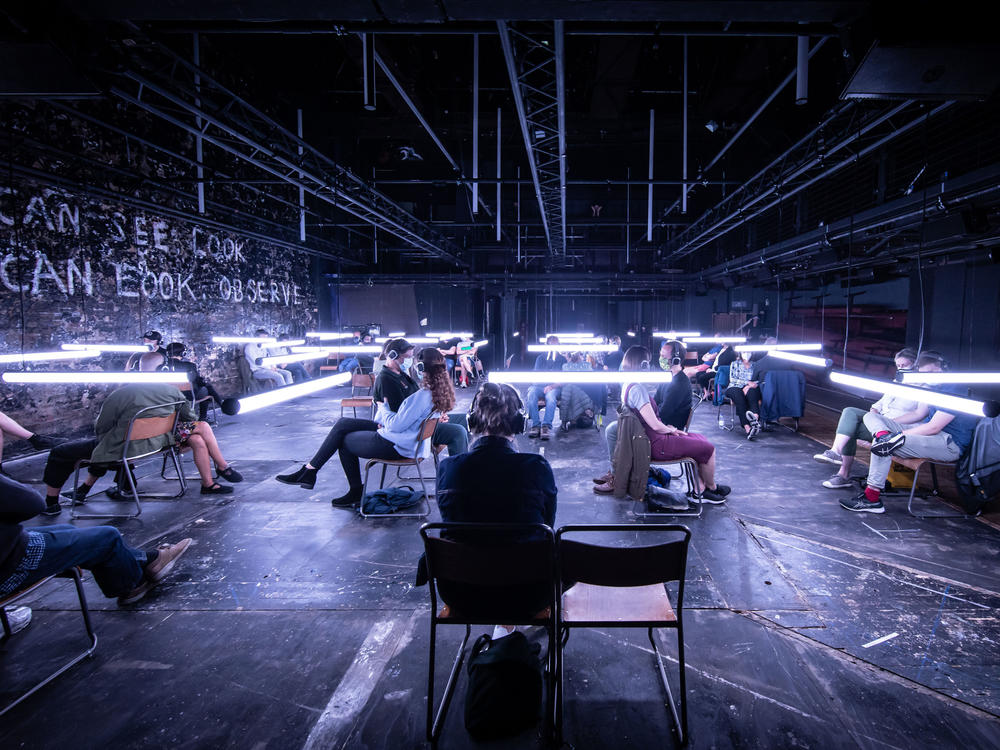Section Branding
Header Content
Indoor Theater Slowly Resumes In A Socially Distanced Way In New York City
Primary Content
Indoor theater has been shuttered in New York City for more than a year, due to safety concerns associated with the Covid-19 pandemic.
But there are indications of slow movement on this front.
Friday is opening night for Blindness at the off-Broadway Daryl Roth Theatre. At a recent preview, there was a short line outside the theater, where invited patrons waited to see the show — a piece based on a novel by José Saramago.
Before entering, a staffer gave instructions: During the 70-minute-long show, there would be no intermission, no re-entry and no public restroom. Attendees had temperatures checked and showed tickets on phones. Then they walked, alone or in pairs, to socially distanced seats spread about the vast auditorium.
What followed was not exactly theater, per se, but a sound and light show. At times, it felt like actress Juliet Stevenson was whispering in your ear, telling you about an epidemic of blindness.
"It's not a traditional play in the way we think of it," says Blindness Producer Daryl Roth. "But what it is, is a wonderful way to story-tell in a safe environment. ... The headphones are sanitized. There is no interaction with actors. There is nothing that isn't comfortable for people to come and gather."
Other producers in the city with access to large, flexible indoor spaces talk about moving towards opening shows by implementing safety measures like separate entrances and exits, new ventilation filters, and no physical Playbills. President and Executive Producer of the Park Avenue Armory Rebecca Robertson says they plan to do COVID-19 tests at the door regardless of vaccination status. "It's a rapid test and it takes 15 minutes to find out what the answer is," she says.
The cost of the rapid COVID tests are included in the $45 ticket price.
The audience will be led, single-file, into the Armory's 55,000 sq. ft. Drill Hall, where seats will be spread out more than 6 ft. apart.
"I can say that with 100 people in the Drill Hall, you feel like you're seeing the work by yourself," Robertson says.
The Armory ran tests in the fall. But its grand reopening slated for last week — with a new piece by choreographer Bill T. Jones — was postponed when several members of the dance company tested positive. The show has been rescheduled for May. Robertson says that while she's disappointed, it proves the protocols work and it's important to build flexibility into their plans.
Over the course of the pandemic, the Armory has been having weekly meetings, via Zoom, with other similar arts organizations to share information, lobby the city and state — and to just commiserate, says Susan Feldman, founder and artistic director of St. Ann's Warehouse in Brooklyn.
"There's a void that we're all feeling," Feldman says. "And it's kind of like how do we bring people together and yet stay safely apart? You can say it both ways. You can say, how do we stay safely apart and still come together? Because we need both."
Feldman's opening her theater in mid-April for a workshop of a new piece by The Bengsons, a husband and wife band. And she's planning a fall season, as is the Armory.
Manhattan resident Laura Knutsen, an audience member who attended Blindness, admitted she'd had some trepidation about returning to the theater.
"It's a pandemic. Large gatherings inside are just a fundamental no," she says. "But it seemed like this might be the best way to possibly transition into normalcy."
Copyright 2021 NPR. To see more, visit https://www.npr.org.

